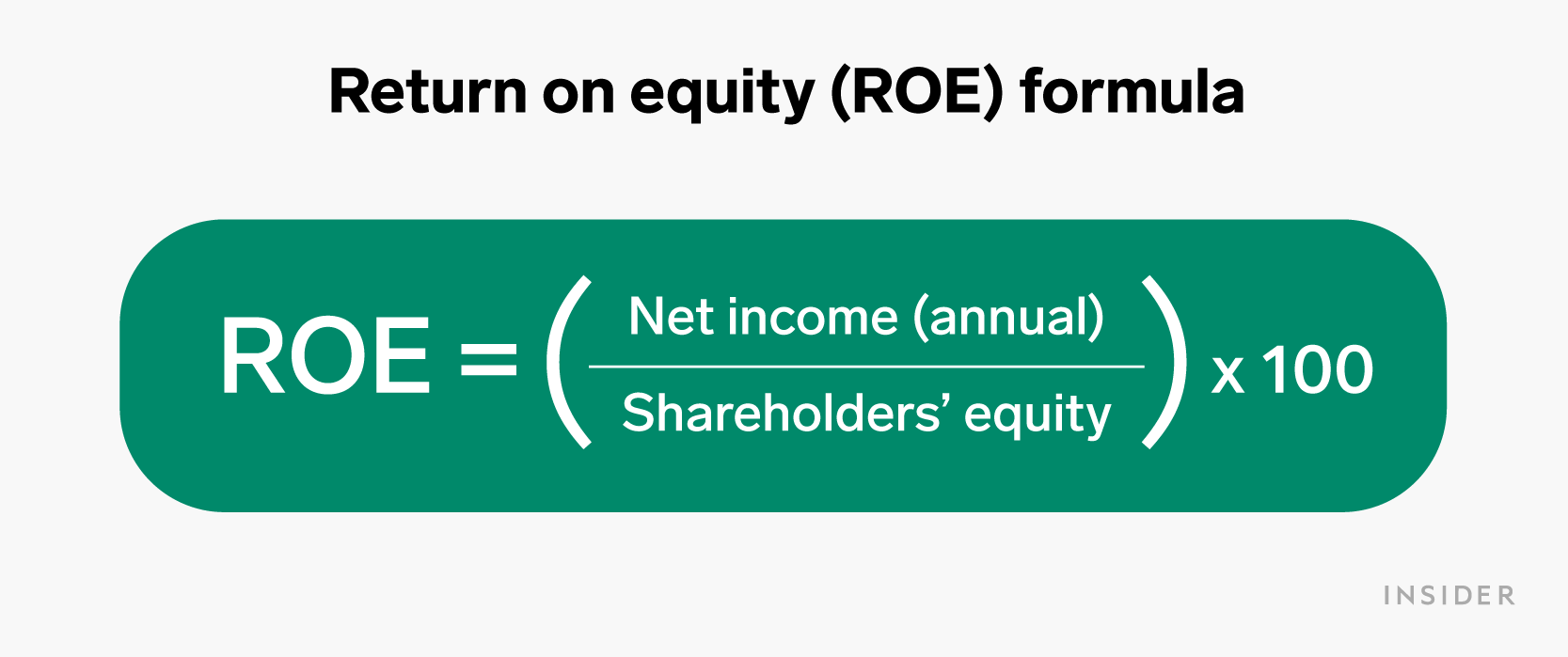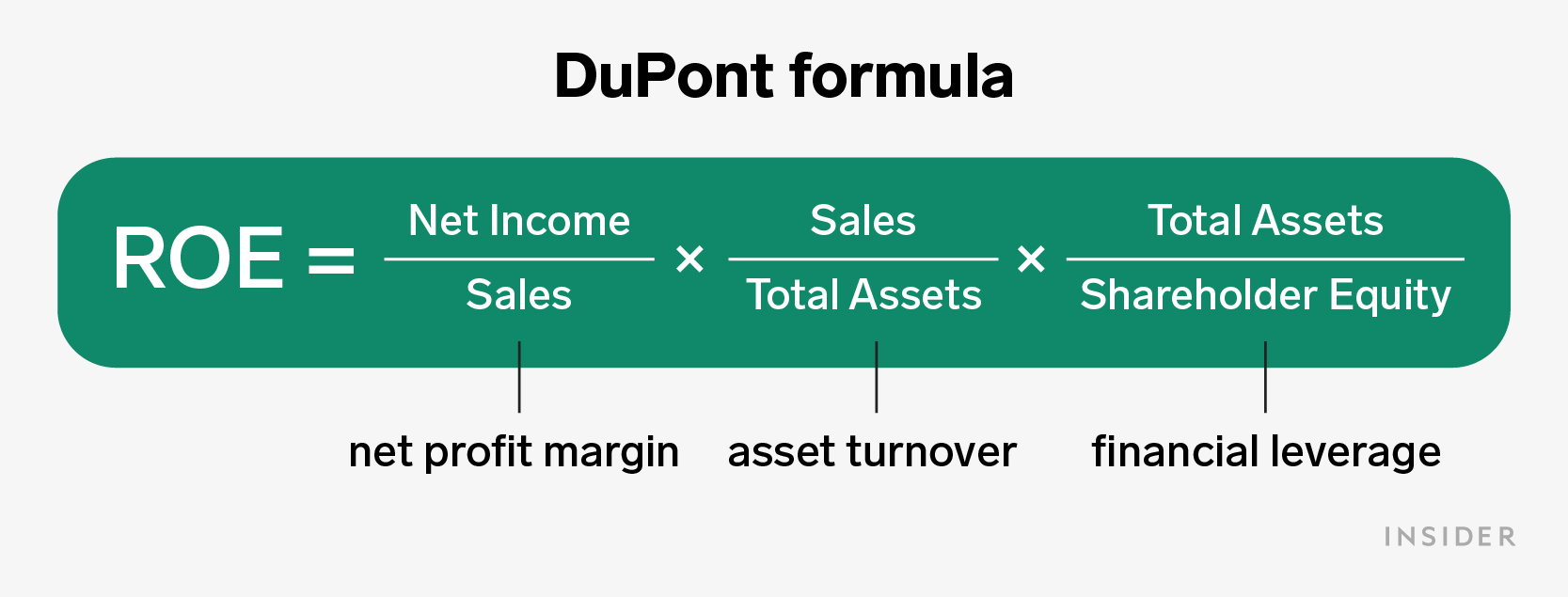
Alyssa Powell/Insider
- Return on equity (ROE) is a financial performance metric that shows how profitable a company is.
- ROE is calculated by dividing a company's annual net income by its shareholders' equity.
- While useful, ROE can sometimes be misleading and can be distorted by dishonest accounting.
- Visit Insider's Investing Reference library for more stories.
The key to value investing is developing a knack for spotting undervalued companies. The value investor is looking for hidden gems – companies with solid management, good financial performance, and relatively low stock price.
Uncovering value stocks requires careful analysis of a company's fundamentals, but some metrics help you separate the wheat from the chaff quickly. Return on equity (ROE) is one of them – it tells you how well a company generates profit from invested cash.
What is return on equity (ROE)?
Return on equity (ROE) is a financial ratio that tells you how much net income a company generates per dollar of invested capital. This percentage is key because it helps investors understand how efficiently a firm uses its capital to generate profit.
Understanding how ROE works
ROE is a useful metric for evaluating investment returns of a company within a particular industry. Investors can use ROE to compare a company's ROE against industry average to get a better sense of how well that company is doing in comparison to its competitors.
A higher ROE signals that a company efficiently uses its shareholder's equity to generate income. Low ROE means that the company earns relatively little compared to its shareholder's equity.
An upward trend in ROE is also a good sign. "While a company's absolute ROE is important, the change in ROE over time - and what drove the change - may be even more relevant," says JP Tremblay, teaching professor of finance in the Daniels College of Business at the University of Denver.
ROE can also be used to help estimate a company's growth rates - the rate at which a company can grow without having to borrow additional money.
How to calculate ROE
To calculate ROE, divide a company's net annual income by its shareholders' equity. Multiply the result by 100 to get a percentage.

Net income: This is a company's income after deducting expenses. A company's annual net income is reported on its income statement
Shareholder's equity: This is the claim shareholders have on a company's assets, after its debts are paid. Shareholder's equity is reported on the balance sheet.
How to calculate ROE in Excel
To calculate ROE in excel, input a company's annual net income in cell A2. Then input the value of their shareholders' equity in cell B2. In cell C2, enter the formula: =A2/B2*100. The resulting figure will be the ROE expressed as a percentage.

ROE can be negative. But that doesn't necessarily mean the company has a negative cash flow. Dr. Robert R. Johnson, professor of finance at Creighton University's Heider College of Business, notes, "companies that are losing money on an accrual accounting basis may have a negative ROE but a positive cash flow." Negative ROE isn't necessarily bad, but it warrants further investigation.
The DuPont Formula
One way to obtain further insight from ROE is by breaking it down into components using a framework called the DuPont analysis. This more advanced analysis decomposes ROE into three ratios, helping analysts understand how a company achieved its ROE, its strengths, and opportunities for improvement.

- The first ratio is net profit margin (net income divided by sales). A company can improve its profit margins by making more money on each unit it sells.
- The second ratio is asset turnover (sales divided by total assets). A company can improve its asset turnover by increasing sales while keeping its total assets constant.
- The third ratio is financial leverage (total assets divided by shareholder equity). A company can improve its ROE by borrowing money and earning more on that money than it costs.
Increasing any of these ratios increases ROE. "Two firms can have the same ROE and get there in completely different ways," says Johnson.
Other uses for ROE
An unusual or extremely high ROE can prompt an analyst to do more research.
- It may signal negative net income. If a company posts both negative income and negative equity, it could result in a misleadingly high ROE. An analyst would want to check that net income and shareholders' equity are positive when interpreting ROE.
- It may signal profit inconsistencies. Imagine a company recorded years of losses against their shareholders' equity. One year with a large net income and artificially low shareholder equity could result in an extremely high ROE. When ROE is sky-high, most analysts would do some digging to check the company's income history.
- It may signal excess debt. Johnson notes that one easy - but risky - way for a profitable company to increase ROE is to borrow money. This is known as leverage. "Leverage works when you can make more money on borrowed money that it costs you," Johnson says. "Of course, leverage is often called a double-edged sword because it can magnify losses when you make less money (or lose money) on borrowed funds than they cost you."
ROE vs. return on assets vs. return on invested capital
ROE tells investors how much income a company generates from a dollar of shareholder's equity. It has some similarities to other profitability metrics like return on assets or return on invested capital, but it is calculated differently.
Return on assets (ROA) tells you how much of a company's profit is being driven by fixed investments like property and equipment. The formula for ROA is almost the same as ROE, but it uses total assets in the denominator whereas ROE uses shareholders' equity.
Return on invested capital (ROIC) also measures profitability relative to investment, but it adds a little more complexity: It tells you how much in net income (after paying dividends) a company generates from all its capital - both debt and equity. ROIC is calculated using net income less dividends in the numerator and the sum of a company's debt and equity in the denominator.
Each of these metrics is used to evaluate and compare companies based on how efficiently their management uses their financial resources to generate profit, but each takes a different angle.
Limitations of ROE
While it's one of the most important financial indicators to stock investors, ROE doesn't always tell the whole story.
For example, it can be misleadingly low for new companies, where there's a large need for capital when income may not be very high. Similarly, some factors, like taking on excess debt, can inflate a company's ROE while adding significant risk.
Another limitation of ROE is that it can be intentionally distorted using accounting loopholes. Inflated earnings or assets hidden off the balance sheet can boost ROE and make a company look more profitable than it really is.
Because of these limitations, the diligent investor should undergo a full analysis of a company's financial performance using ROE as one of several metrics.
The financial takeaway
ROE is one of the most important financial ratios for the stock investor hunting good value companies. It's a straightforward and handy indication of how well a firm is able to generate revenue from the money invested in it. High and stable ROE is generally better, but the absolute number should be considered in the context of the industry. It's also a good sign if ROE increases over time.
Use ROE to sift through potential stocks and find the companies that turn invested capital into profit fairly efficiently. That'll give you a short list of candidates on which to conduct more detailed analysis.
